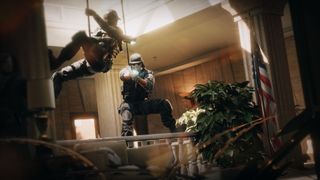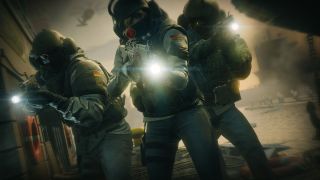
Even at its lowest skill levels, Rainbow Six Siege is a difficult game. Despite the divide between the Casual and Ranked modes, there’s no version of Siege that isn’t intense, challenging, and brutal. For relatively new players looking to dip their toes into Ranked, we’re breaking down all of the differences from Casual with some general guidelines for adjusting your play-style to the less forgiving mode.
Round timer decreased from 4 minutes to 3 minutes
Shorter round times stand out as the single most important change from Casual. One minute might not seem like that much at first, but after a few attacking rounds you’ll no doubt find yourself with 20 seconds left and nowhere near the objective yet. That missing minute means that you can’t waste any moment while attacking. Droning an entire floor is nice, but using up that time is a big commitment. Be efficient with your droning and always be making moves towards the objective.
As a defender, the time decrease is an all-around bonus. The time limit only puts pressure on the attackers, but you do need to be ready for teams to push the objective earlier in the round. After a long time of playing mostly ranked, the three minute timer feels like an overall better pace for the game. It keeps everything moving and prevents rounds in Casual where nothing happens for a full minute while the last attacker left slowly creeps around.

Teams choose the defence site and attack spawn
Alongside the shorter rounds, this is the alteration that will affect your play-style the most. Ranked does away with the randomly chosen defence sites and spawns and puts it to a vote instead. Knowing where you’re about to defend lets you form your operator composition around what’s best for the situation. If you know you’re headed to the CEO Office on Bank, Castle is a solid pick. If the team votes for Lockers instead, you’re better off with Kaid to electrify the hatches.
As you play more Ranked, you’ll start to learn which sites are considered “better” than others and be able to predict where the enemy will go. If you’re attacking Coastline, you can bet they’re defending Penthouse first. Choosing where to spawn for the attack is also incredibly useful. The freedom to choose whether you begin close or far from the objective lets you better plan your approach and catch the enemy off guard. In Casual, the whole team spawns in the same place. This is bad news when a spawn peeker is around, but in Ranked the team can split up across the map and minimise this.
Matches can be much longer, thanks to overtime
The way matches are scored in Ranked is a lot different. Instead of the simple “first to three” system from Casual, the winner in Ranked is the first to four, unless the match reaches 3-3 overtime. In overtime, teams must win two more rounds to take it home with a total of five. Ranked also locks you out of defending a site if you’ve already won there, forcing your team to mix it up and go somewhere else. This lockout resets once overtime begins, so both teams are guaranteed a chance to attack and defend anywhere they want. In a match that extends to its max length, you’ll play a maximum of nine rounds!

Skill level is generally higher, and so is organisation
It’s definitely not a given that everyone will be taking the game more seriously just because it’s Ranked, but you’ll generally notice more effort put towards strategy. This shows up most in team compositions. Defending with whatever operator suits your fancy is definitely an option, but expect the enemy to bring along Thatcher, Hibana, and Buck to make your job as difficult as possible. It’s not that you’re sure to lose without a perfect composition, it’s just always a good idea to bring along Bandit or Kaid and maybe a Jager as general deterrents.
Your performance will determine your rank
As you might expect from a mode called Ranked, your performance in each match is ultimately scored with MMR (matchmaking rank) and classified into one of six tiers: Copper, Bronze, Silver, Gold, Platinum, and Diamond. Each tier has several sub-tiers (Gold 3, Gold 2, Gold 1 for example) with Diamond being the highest achievable rank. Each Ranked season lasts about three months and is reset when a new season of operators releases.
At the beginning of each season, players have to complete ten placement matches before their first rank for the season is established. No matter where you initially end up in the rankings, you can always rank up or down depending on your wins and losses. Wins award a good amount of MMR, but losses are more harshly graded against your rank and will degrade it quickly. At the end of the season, ranks are reset and players are awarded a unique weapon charm for the highest tier they reached. Even if you started in Gold but dropped to Silver, you’ll still receive a gold charm in the end.
Wrap up
That’s all you need to know to jump into Ranked! Above all else, it’s important to be communicative with your team and have a general plan going into each round. It can take some time to adjust to the stricter rules of Ranked, but you’re rewarded with a much more tactical and competitive environment.
The biggest gaming news, reviews and hardware deals
Keep up to date with the most important stories and the best deals, as picked by the PC Gamer team.
